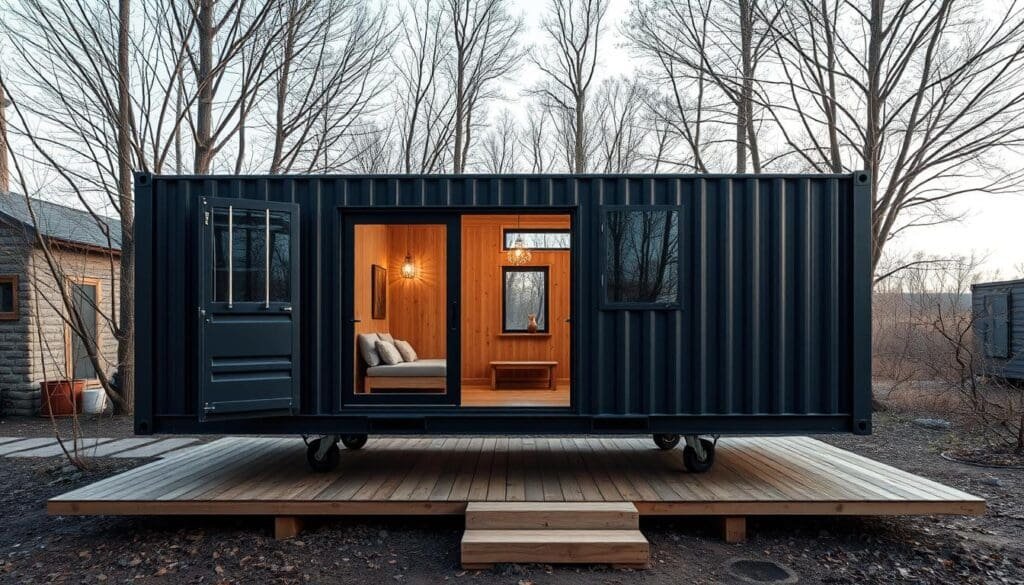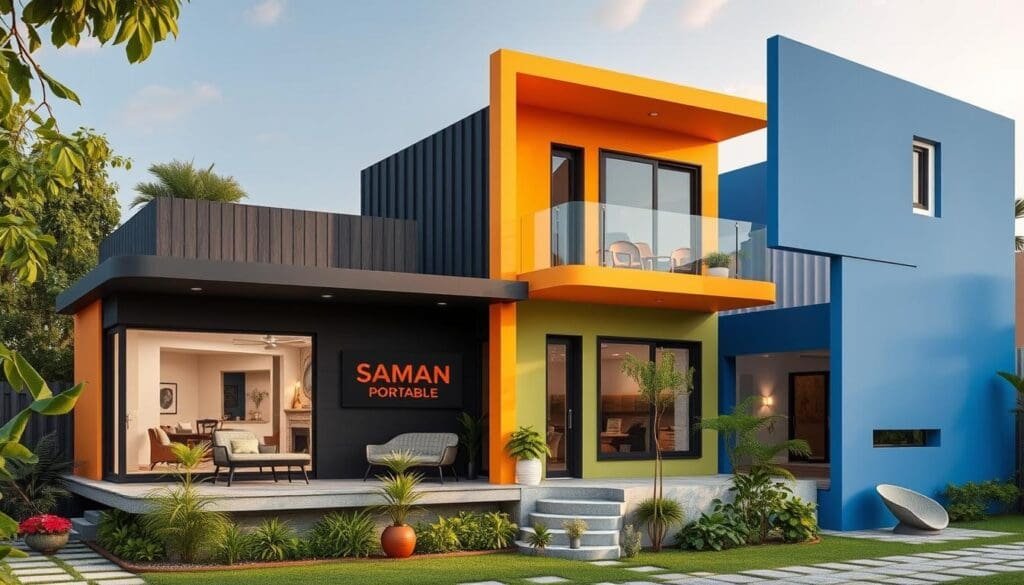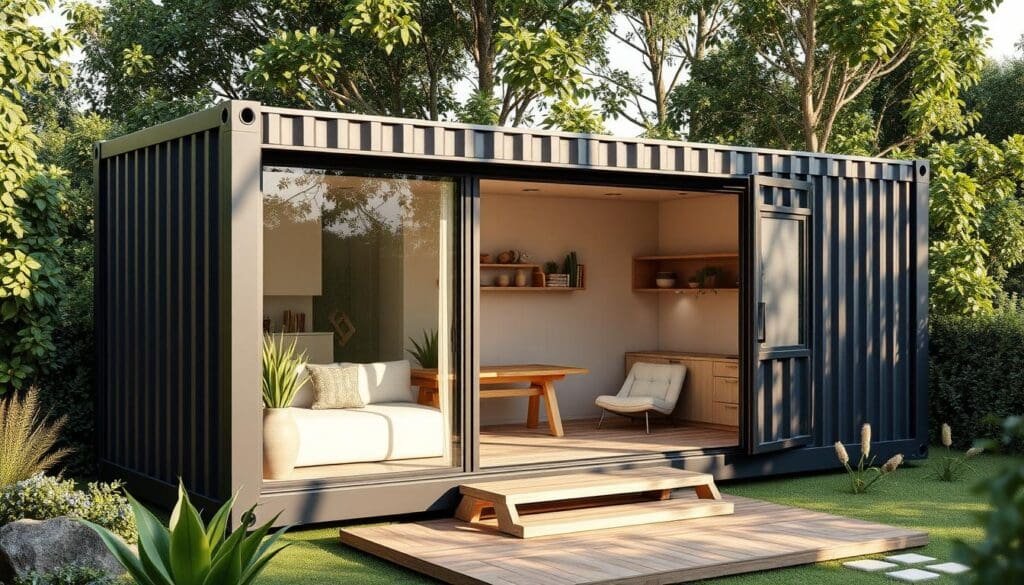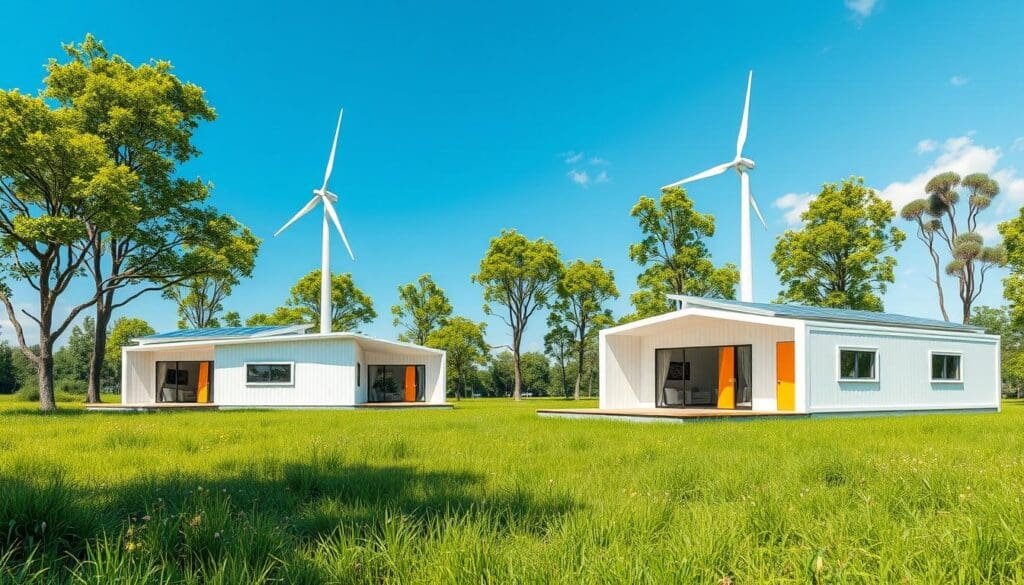Container Architecture: Sustainable Designs Shaping the Future of Modern Living Spaces

The world is moving towards sustainable living, and a new approach in architecture is gaining attention. Container architecture turns old shipping containers into useful, green homes and buildings. These metal boxes can be more than just shelter; they can be symbols of sustainability and new technology.
Exploring container architecture might reveal a path to a greener, more flexible future. It’s an exciting idea that could change how we live and work.
Key Takeaways
- Container architecture offers a sustainable, cost-effective, and versatile alternative to traditional construction methods.
- Repurposed shipping containers can be transformed into modern, energy-efficient living spaces and commercial structures.
- Innovative container designs prioritize environmental impact, incorporating features like solar panels, rainwater harvesting, and natural ventilation.
- Customization and smart home integration make container homes tailored to individual needs and preferences.
- Experienced contractors, such as SAMAN Portable Office Solutions plays a crucial role in successful container architecture projects.
Evolution of Sustainable Architecture in Modern Design
Sustainable architecture has changed a lot, moving from old building ways to new, green methods. The growth of portable architecture and prefabricated office containers has led this change. It tackles environmental issues and shapes the future of homes and buildings.
From Traditional Buildings to Innovative Solutions
For a long time, building methods have had a big environmental impact. But, there’s now a big push for green practices. Projects like SOM’s ‘Urban Sequoia’ and Seratch’s carbon-neutral cement show a new way forward.
The Rise of Container-Based Construction
Prefabricated containers have become a big deal in green building. Places like the new Terminal 2 in Bengaluru, India, and a project in São Paulo use these containers. They cut down on carbon and use resources wisely.
Environmental Impact Considerations
Green architecture focuses on reducing the harm of old building ways. Projects like Knox Bhavan’s March House and 43 examples worldwide show a dedication to being green. They aim to cut waste, save energy, and use recycled stuff.
The shift towards sustainable architecture shows a big change in the industry. It’s about fighting climate change and making cities better. Architects are using new ideas, tech, and caring for the planet to create a greener future.

Container Architecture: Principles and Core Concepts
Modular container design and sustainable container spaces are key to a new way of building. This approach focuses on being green, flexible, and creative. It uses modular design for easy changes, keeps buildings warm or cool with smart insulation, and picks materials and tech that are good for the planet.
This method follows the Passivhaus standard, aiming for very low energy use and less harm to the environment. It keeps buildings comfortable and functional. It also looks at the whole life of a building, from start to end, making sure it’s good for the future.
- Modular design lets you change and grow your container spaces easily.
- Smart insulation and design help keep energy use down, making buildings warm or cool.
- It uses green materials and new tech in its design.
- The Passivhaus standard helps make container spaces that use very little energy but are still comfy.
- It considers a building’s whole life, from start to reuse, for lasting sustainability.
Container architecture is leading to a future of buildings that are modular, green, and can change. It’s changing how we think about and live in modern buildings.

The Environmental Benefits of Modular Container Design
Eco-friendly container homes are a green way to live. They use shipping containers to make homes that save energy and cut down on waste. These homes are built to be energy-efficient and help reduce carbon emissions.
Energy Efficiency Features
These homes focus on saving energy. They have good insulation and smart systems for controlling the climate. They also use solar panels to generate power.
Using old shipping containers for homes helps cut down on carbon emissions and saves energy. They use solar panels and energy-saving bulbs to help the environment.
Waste Reduction Strategies
Container homes are built in a way that reduces waste. They are made in a factory, which means less waste on the construction site. Using recycled shipping containers also cuts down on greenhouse gas emissions.
Corten steel containers help keep the home warm and save energy. This makes the home more sustainable.
Carbon Footprint Minimization
These homes help reduce carbon emissions. They need less transportation and use materials efficiently. Building with containers also promotes green building.
Using containers for homes helps save fuel and cut down on emissions. It supports living in a more eco-friendly way.

Modular container design offers many environmental benefits. It’s a great choice for those who want to live sustainably without giving up modern comforts.
Materials and Construction Methods in Container Architecture
Container architecture is a green and creative way to build. It uses prefabricated containers as the main building blocks. These strong, modular structures are then made better with eco-friendly materials and building methods. This makes them more energy efficient and kinder to the environment.
Steel shipping containers are at the center of this architecture. They are tough and versatile. To make them even better, recycled denim or sheep’s wool insulation is added. This mix of steel and eco-friendly insulation makes the buildings well-insulated and energy smart.
Building with containers focuses on making things off-site. This cuts down on on-site work time and reduces environmental harm. New methods, like 3D printing for parts and using bio-based materials for finishes, are becoming popular. They make these container buildings even more sustainable.
| Advantages of Container Architecture | Disadvantages of Container Architecture |
|---|---|
|
|
Container architecture is versatile and used in many ways. It’s for affordable homes, offices, emergency shelters, and even medical clinics. It’s all about being sustainable, durable, and built efficiently. This approach is changing how we think about modern living spaces.

Smart Integration and Technology in Container Homes
The future of container homes is bright thanks to smart technology. Now, systems control lights, temperature, and security. This makes living in portable architecture more comfortable and energy-efficient.
Smart homes also use new energy solutions. These include smart meters, solar power, and battery systems. They help homes live off the grid, reducing harm to the environment.
Container homes are getting smarter too. They use furniture that does more than one thing and foldable parts. AI helps adjust the layout based on how you live. These techs make living better and homes more adaptable and green.
Automation Systems for Container Living
Automation is changing how we live in container homes. It controls lights, temperature, and security. These systems work together to make homes comfortable and efficient.
Energy Management Solutions
Container homes focus on being green, and energy solutions are key. Smart meters, solar power, and batteries cut down carbon emissions. They often let homes live off the grid, making them more self-sufficient.
Smart Space Optimization
Container homes are already space-smart, but tech is making them even better. New furniture and AI adjust layouts for better use of space. This ensures every inch is used well.

As people want more sustainable homes, container homes with smart tech are leading the way. They’re changing the future of portable architecture for the better.
Designing Multi-Purpose Container Spaces
Modular container design and container office design bring flexibility to living and working spaces. These structures can change from homes to offices to community centers. They meet the changing needs of today’s lifestyles.
Designing these spaces requires smart planning and creative layouts. Modular designs, movable walls, and furniture that changes shape help spaces adapt quickly. This makes the most of the space and makes it easy to change. Whether it’s a cozy home, a lively office, or a community spot, the goal is the same: be versatile, use space well, and be durable.
- Modular layouts with easily reconfigurable elements enable seamless transitions between various functions.
- Movable walls and partitions grant the freedom to create open, collaborative environments or private, segmented spaces as required.
- Convertible furniture, such as murphy beds and transformable tables, further enhance the adaptability of container-based spaces.
Using modular container design, architects and designers can make structures that last long. This reduces the need for expensive new buildings as needs change. It also supports sustainable and eco-friendly design goals.
The versatility of container architecture is seen in projects like the Transcon Developers’ sales office in Mumbai, India. It uses old shipping containers to create a modern workspace. This shows how containers can be turned into useful, beautiful, and affordable spaces. It proves that containers can be changed to meet the needs of businesses and communities.
Sustainable Features and Green Technologies
Eco-friendly container homes lead in modern design, using many sustainable features and green technologies. These innovations cut down on environmental harm. They also make living in these homes more efficient and comfortable.
Solar Integration Solutions
Container homes often use solar panels to turn sunlight into electricity. This cuts down on the need for traditional energy. They also have solar water heaters for hot water, lowering carbon emissions.
These solutions help make container homes more independent and energy-smart.
Water Conservation Systems
Container designs focus on saving water with new systems. They collect rainwater for uses like watering plants and flushing toilets. They also recycle greywater from sinks and showers for plants.
Using less water, these homes are more sustainable. They use low-flow fixtures and appliances too.
Natural Ventilation Strategies
Eco-friendly homes use natural air flow to cut down on energy use. They use cross-ventilation and stack effect to control temperature. This makes homes cooler without using a lot of energy.
These strategies improve air quality and make homes more comfortable. They show a smart way to live sustainably.
By combining these green features, container homes show a new way to live. They use less resources, save money, and help the planet. This is a step towards a greener future for container homes.

| Sustainable Feature | Key Benefits |
|---|---|
| Solar Integration | Reduced reliance on non-renewable energy, lower electricity bills, and a smaller carbon footprint |
| Water Conservation Systems | Decreased freshwater usage, efficient resource management, and sustainable water practices |
| Natural Ventilation Strategies | Improved indoor air quality, decreased energy consumption for climate control, and enhanced overall comfort |
Urban Applications of Container Architecture
Portable architecture and container office design are becoming key in cities. They offer new ways to meet urban needs, like affordable homes and temporary event spaces.
In crowded cities, container buildings can stack up to create vertical villages. They use empty lots or rooftops for living and working spaces. This makes the most of urban areas.
Building with containers is fast and cheap, helping solve housing problems. They can be made elsewhere and set up quickly. This cuts down on construction time and neighborhood disruption.
Containers are also used for city shops, galleries, and events. They turn empty spaces into lively spots. This makes cities more vibrant and adaptable.
Container design brings flexibility and sustainability to cities. It opens up new ways to make places, engage communities, and use resources better. This approach meets the need for green, strong, and flexible urban spaces.
| Application | Key Benefits | Noteworthy Examples |
|---|---|---|
| Affordable Housing |
|
|
| Pop-up Retail Spaces |
|
|
| Temporary Event Venues |
|
|
Container architecture is changing cities for the better. It tackles issues like housing and sustainable infrastructure. As it grows, it will shape urban futures with practical and creative solutions.

Cost-Effectiveness and Economic Benefits
Prefabricated containers and sustainable container spaces are very cost-effective. They often cost less to build than traditional houses. This is because they use less material and can be built faster.
This fast building process means more homes can be built quickly. It also creates jobs in areas like welding and carpentry. This boosts the economy and helps people learn new skills.
In the long run, these buildings save money on energy. They are designed to use less power and have sustainable technologies. They also need less maintenance because they are durable and made with easy-to-care-for materials.
The modular design of these buildings makes it easy to add or change things. This means you can adapt your space without spending a lot of money.
Leveraging Recycled Materials
Using shipping containers for homes helps the environment. It reduces the need for new materials and cuts down on waste. This aligns with green building practices.
Companies like SAMAN Modular Innovations show how using shipping containers can save money and be good for the planet. They contribute to sustainable building and cost savings.
Optimized Construction Processes
SAMAN Portable in Bangalore, India uses old shipping containers, which are cheaper than new materials. This makes building more affordable for clients. The company is great at turning these containers into homes off-site.
This approach cuts down on construction time and costs. It also reduces the impact on the area around the building site.
Customization and Flexibility
There are many ways to customize these buildings. This allows for a wide range of structures, making the most of the space. It also adds value for the people who use them.
The ability to move or expand these buildings is a big plus. It means you can change your space without a lot of hassle or expense.
| Metric | Traditional Construction | Prefabricated Container Homes |
|---|---|---|
| Initial Investment | Higher | Lower |
| Construction Timeline | Longer | Shorter |
| Energy Costs | Higher | Lower |
| Maintenance Costs | Higher | Lower |
| Expansion Flexibility | Limited | Increased |

Arabian Containers helps the environment by using shipping containers again. This follows the circular economy idea, which aims to reduce waste. The containers are made to last, with weatherproofing and coatings that prevent rust.
Portable and Adaptable Design Solutions
In modern architecture, portable architecture and modular container design are changing the game. They make living spaces flexible and sustainable. These structures can move, change shape, and use again as needs shift.
Using portable containers can cut down on waste in building. They come with green tech like solar panels and LED lights. This reduces harm to the environment. Plus, they can turn into meeting rooms, offices, or shops as needed.
Containers are easy to move, fitting into different places for various needs. They’re great for disaster relief, construction, or seasonal events. This makes them perfect for cities.
- Portable containers are built tough, ready for the elements.
- They can be made cozy with modern insulation, saving energy.
- Containers can be customized a lot, unlike cabins.
Shipping containers for buildings have grown a lot in ten years. They’re fast to build and cost-effective. This makes them ideal for businesses needing quick, affordable spaces.
| Feature | Portable Cabins | Shipping Containers |
|---|---|---|
| Design Purpose | Designed for people to live in | For storing and moving goods |
| Setup | Ready to use right away | Needs more work to be ready |
| Durability | Not as tough as containers | Can handle the elements |
| Aesthetics | Can look any way you want | Has a unique look that can be improved |
Portable and modular designs are a smart choice for today’s living and work needs. They’re flexible, green, and save money. They’re great for temporary or permanent buildings.

Integration with Natural Surroundings
Eco-friendly container homes blend well with nature, creating a perfect mix of built and outdoor spaces. Techniques like green roofs and vertical gardens make the industrial look of shipping containers less noticeable. This helps the home feel more connected to its surroundings.
Landscaping Techniques
Green roofs on container homes look great and help with insulation and air quality. Adding vertical gardens and plants makes the home feel like it’s part of nature. This creates a smooth transition between the home and the outdoors.
Biophilic Design Elements
Biophilic design brings nature into buildings. It uses lots of natural light and organic materials. This design makes people feel closer to nature and improves their well-being.
Container homes that blend with nature show the power of good design. They prove that sustainable design can make both the environment and people healthier. This leads to a future where eco-friendly container homes and sustainable container spaces live in harmony with nature.
Commercial Applications and Office Spaces
Container architecture is becoming popular for commercial and office spaces. It offers flexible, cost-effective solutions for startups, co-working spaces, and temporary offices. The modular design of container offices makes it easy to customize for different business needs.
These structures can have open-plan layouts or private meeting rooms. They often include sustainable features like solar panels and smart energy systems. This meets corporate sustainability goals.
The unique look of container structures can also be a branding tool. It attracts attention and shows a company’s innovative and green image. Businesses are choosing container office design and prefabricated containers for their versatility and cost-effectiveness.
As more people want flexible and green office spaces, container architecture is set to change the commercial scene. It uses modular design and eco-friendly features. This helps companies improve their workspace, cut costs, and lead in sustainable business practices.
FAQ
What is container architecture?
Container architecture is a new way to live sustainably. It turns old shipping containers into modern homes. This method is good for the planet, saves energy, and is affordable.
How does container architecture contribute to sustainable design?
It’s great for the environment. Containers are well-insulated and have smart systems for controlling the climate. They also reduce waste and cut down on carbon emissions.
What are the core principles of container architecture?
It’s all about being modular, energy-efficient, and using green materials. These ideas help make homes that use very little energy and are good for the planet.
What sustainable features and green technologies are commonly found in container architecture?
You’ll find solar panels, water-saving systems, and natural ways to cool the air. These features help the environment and save money on bills.
How does container architecture address urban challenges?
It solves big city problems like finding homes and creating shops. Containers can be set up quickly in empty spaces. This helps cities grow and change.
What are the economic benefits of container architecture?
It’s a smart choice for your wallet. It costs less to start and saves money over time. Plus, you can change it as your needs do, making it a smart investment.
What are the advantages of the portable and adaptable design of container architecture?
Containers are easy to move and change. They’re perfect for temporary homes, offices, or even disaster relief. You can grow or shrink them as needed, saving resources.
How does container architecture integrate with natural surroundings?
It blends in with nature beautifully. Using plants and green roofs makes it feel like part of the landscape. This improves air and makes living there healthier.
What are the commercial and office applications of container architecture?
It’s great for businesses too. Containers can be made into offices, co-working spaces, or even startup homes. They’re flexible, green, and can even help a company look cool and eco-friendly.
 Container Cafe
Container Cafe



























































































